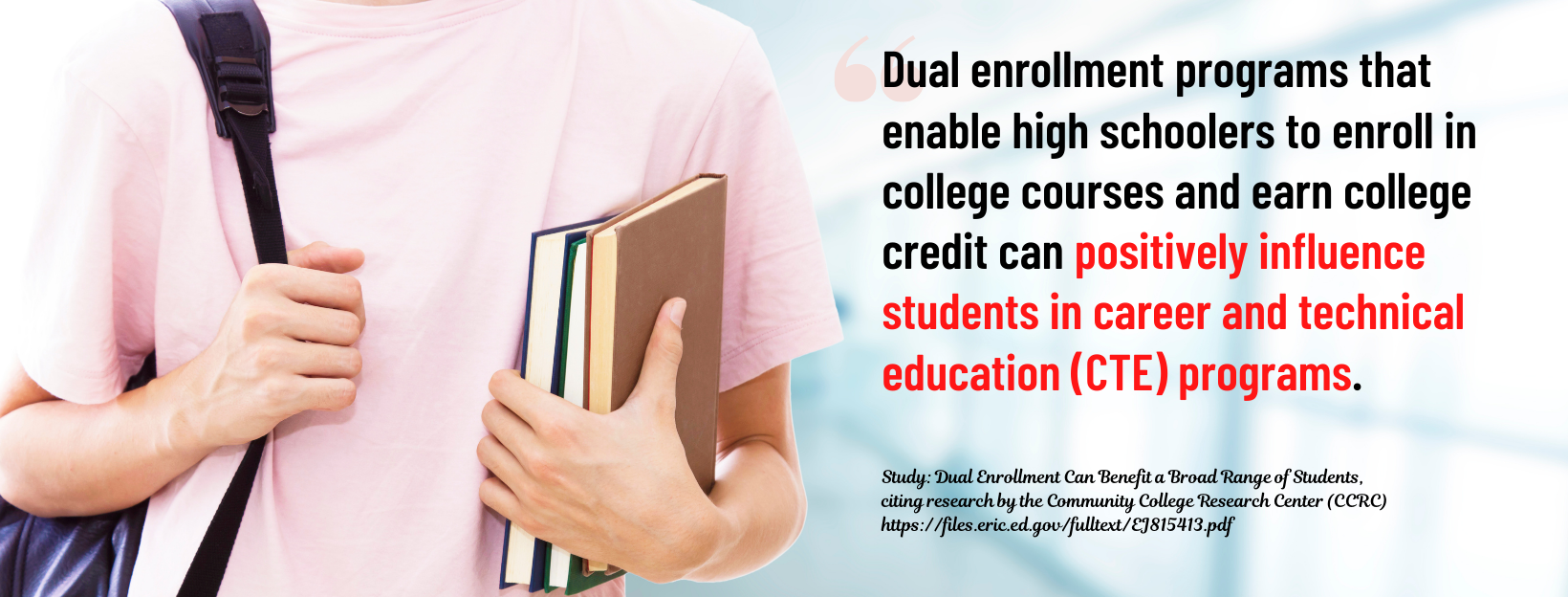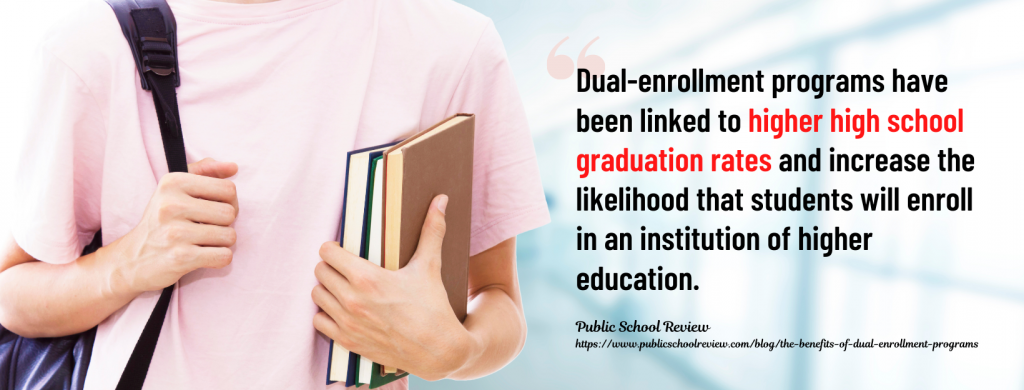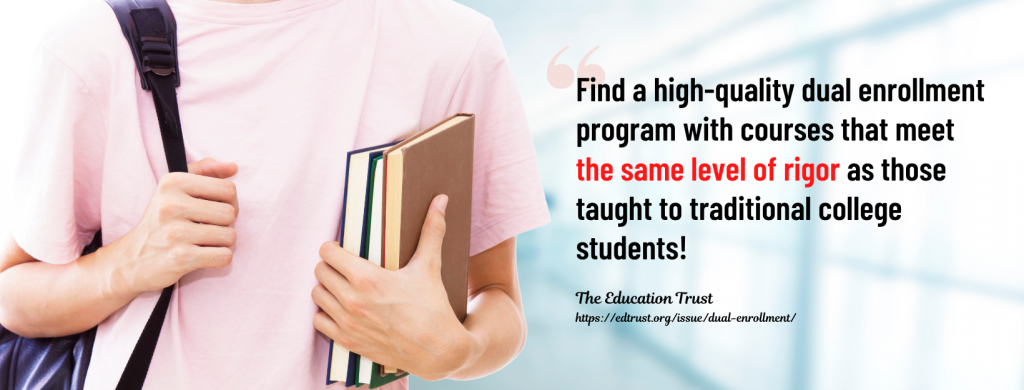What is College Dual Enrollment?
Find your perfect college degree
If you are enrolled in your third year or last year in high school and have begun planning for this year’s or next year’s courses, why not give dual enrollment a shot? This system is structured to prepare a high school student for rigorous coursework in higher education.
The National Alliance of Concurrent Enrollment Partnerships published research stating that about 10% of high school students in 2010-2011 took college courses from post-secondary educational institutions. Most of these students belonged to the junior and senior levels.

Currently, the Community College Daily reports a surge in dual enrollments all over the country. This is primarily due to the Coronavirus pandemic. With the current shortcomings and uncertainties over most high schools’ reopening schedules, students decide to shift to dual enrollment options instead of focusing on sports and other extra-curricular programs.
Job opportunities have declined in number due to the circumstances, making dual enrollment programs—which translate to college credits earned for a faster transition to higher education–even more suitable.
All these have led to a surge in dual enrollment, with community colleges reporting a 300% increase in their statistics last summer!
Learn more about Dual Enrollment using these page jumps!
Dual Enrollment Defined

Dual enrollment is often referred to as “concurrent enrollment,” which means that a high school student can be enrolled and admitted to dual enrollment programs in two different schools simultaneously. High school students earn college credits through these classes while attending a brick-and-mortar college or an online college course.
In a dual enrollment program, you should complete a series of coursework to get a final grade reflected in your transcript. It will also automatically give you a course credit that can help expedite your college application. Suppose you are wondering how dual enrollment programs differ from Advanced Placement.

In that case, the ultimate difference is that, instead of taking high school courses with college-level content, you will be enrolled in real and legit college courses.
This might be too advanced for some other high school students. If you are up for the challenge, it may be time to test the waters and enroll in concurrent courses.
Depending on the dual enrollment program you select, you can attend a nearby college or enroll in an online program at your choice college.
Being in an actual college setting will give you a glimpse of how college life feels. You will meet new peers and be fully immersed in a college environment to ease your higher education journey transition.
Once you experience attending classes physically in a college, you will discover and understand more about choosing the right major to pursue later.
Comparing Advanced Placement and Dual Enrollment Programs
Advanced Placement and Dual Enrollment classes are usually compared to each other because of their similarities. Both programs offer high schoolers an opportunity to gain college credits even while still studying in high school. These are generally beneficial to the student in terms of cost-efficacy and time efficiency.

However, there are significant differences between the two:
- Dual enrollment programs are usually a replacement for high school classes. Students earn a final grade that will permanently impact their high school and college transcripts. These programs will require you to earn a grade of C or higher to be able to pass.
- The College Board designed the Advanced Placement program as a series of different classes to prepare the students for the AP exams. Acceptable performance in the AP Exam is your ticket to earning college credit. You can also take advanced courses upon entering college.
In conclusion, neither course guarantees acceptance by all colleges and universities in the US. There will be learning institutions that will not credit these courses to a student’s academic record or degree.
It also won’t replace some traditional prerequisites set in taking advanced techniques, for example.
Before leaping faith in either of these programs, speak to your high school counselor or principal. Find out if the option will work best for you and your academic goals!
How is Dual Enrollment different from Dual credit?

High schools all have limits on what they can offer as Dual Credit courses because they must have qualified teachers on staff. Because Dual Enrollment courses are taught on Jefferson College campuses or online, students have a wider range of general education subjects and instructors to choose from.
Furthermore, evening classes may be more convenient for the student’s schedules. Students who want Dual Enrollment courses to count for high school credit should consult with their high school guidance counselor.
Some colleges have agreements with local high schools that allow students to earn up to 42 hours of college credit in general education or even an associate degree through Dual Credit and Dual Enrollment courses.
Guidance counselors at the student’s high school can provide additional information.
Why is Dual Enrollment Necessary?

Dual Enrollment is perceived as a jump-the-gun option for those who want to earn an advantage in their college requirement. It is a rising trend for most high schools in the country.
If you are a high-ability student who wants to turn your educational experience up a notch, joining dual enrollment programs will give you the right challenges for intellectual growth.
However, before you get into this concurrent education arrangement, you will have to take on some proficiency-based eligibility measures. Once you pass them all, get ready for some leveled-up higher educational courses.
One of the essential things to note about dual enrollment is that it requires commitment. Studying these college-level courses will not be a walk in the park. It may entirely be an incredible experience for you. You will be enrolled in a curriculum that is a level or two higher than your current standing.
The effort and work required for these dual enrollment programs are far more significant than your high school courses. Moreover, your grade for these courses will take a permanent spot in your college record, so do your best to gain an acceptable or above-average academic score!
If you are interested in the concurrent enrollment program, speak to your high school counselor. You will also need the approval of your local high school before proceeding with the application.
It would be smart for you and your family members to attend and register for dual enrollment program orientations. Besides accelerating your education as a whole, you will save more on tuition and school expenses and expedite your college journey.
The Pros and Cons of Dual Enrollment

Although most educational experts believe in its win-win value for young learners, you must carefully consider the elements that make up a dual enrollment program before deciding on it. Here are some of the pros that will indeed urge you to take a dual enrollment program:
1. Dual enrollment program students are most likely college students who are soon graduating.
The Community College Research Center’s 2017 national study reports that 88% of the students enrolled in dual enrollment programs pursued a college degree after graduating from high school.
They also earned a certificate and finished a degree of up to five years. Another study published by Sagepub.com involving Illinois high school students proved this similar benefit.
Of some 8,095 research participants, it was found that those who did enroll in the dual enrollment program were 9% more likely to obtain a bachelor’s degree than those who did not pursue this program.
2. Dual enrollment courses cost less than conventional college courses.
Depending on your state location and high school, some dual enrollment courses are paid for by the state or high school district. But if, in any case, you are not eligible for such free educational benefits, you will still need to pay a lower tuition fee for dual enrollment courses than for traditional college courses.
It is common knowledge that college fees are way more expensive than any education level in the United States. A dual enrollment course will cost you $0-$400, making it a more cost-effective option.
3. Dual enrollment can give you credits for your college application.
In some universities and colleges, the Admissions Committee considers dual enrollment a competitive advantage over other student applicants. Once you have it, it will help you become more qualified to be enrolled in your preferred higher education institution.
If you have good grades in these college courses, most university schools will view and anticipate you to be academically ready and prepared for their rigorous coursework.
4. Dual enrollment students give an insight into real college life.
By physically attending colleges for your dual enrollment courses, you will expose yourself to its realities. You will have a better understanding and perspective of preparing for college. You will no longer have a hard time transitioning into a new phase in your academic life.
You will develop more confidence and better understand what you want to take as a major when you finally attend college.
The upsides are attractive, but can dual college programs not be for you? Here are some of the known downsides of this option:

1. Your college dual enrollment courses may distract you from focusing on your high school classes.
No matter how excellent you are in your high school classes, you might miss some prioritized tasks and assignments.
This will ultimately become a regular occurrence with dual enrollment because your plate will be full by then, and you will have to accomplish numerous tasks for the different curricula. You can lose focus on the priority: your high school classes.
No matter how beneficial your college course credits are, you need to ultimately pass and excel in your high school classes. After all, your high school performance has everything to do with your eligibility (or ineligibility) for college credits.
2. Some colleges and universities do not honor dual enrollment credits.
The reality of the matter is that not all colleges offer credit for dual enrollment classes. Some colleges do not recognize college courses taught by a high school teacher. Accreditation standards have been improved by the National Alliance of Concurrent Enrollment Partnerships, increasing the number of public colleges and universities that are finally accepting dual enrollment credits.
3. The grades you earned in dual enrollment programs are permanent.
Since taking a dual enrollment course means being enrolled to study a “real” college course, your overall score is taken as your final grade when you complete it. It will be the one recorded on your college transcript.
Unless you are fully confident in performing in college-level learning, try to reassess whether you are up for such an academic challenge.
Eligibility Requirements for Dual Enrollment
Suppose you are seriously considering attending a college dual enrollment program; you must first check the eligibility requirements. Each state has specific qualifications and conditions to follow.
The first essential step is to approach your high school principal or counselor for comprehensive information about this system in your school.
Next, check all the requirements and see if you qualify:
- Candidates for dual enrollment should be at least 16 years old and not older than 21. It is best to enroll while in your sophomore, junior, or senior year in high school.
- You should have completed 12 post-secondary credit hours or are at least on your way to completion.
- You need to maintain a 2.5 to a 3.0 GPA.
- You should secure a letter of approval or recommendation.
- A high score on initial placement tests is an advantage.
- You must demonstrate high academic performance in your high school classes.
Lastly, inform your parents and family about your plans to join a dual enrollment program. This way, you can earn their full support, and you can also prepare them for any financial backing that you might need in case your state does not provide financial aid.

How to Pay for Dual Enrollment Courses?
Once you have been eligible to enroll in dual enrollment programs and have met all the prerequisites, it’s time to prepare and organize your concurrent enrollment courses’ financial means. As often is the case, your school district is the one responsible for paying your tuition fees.
The Education Commission of the States has broken down all 50 states’ policies on dual enrollment programs, and you can refer to their site for more details about your state district requirements.

According to the Commission, there are about nine states where students and parents pay educational fees. In 11 states, the financial responsibility is on anyone, depending on the dual enrollment program.
Once enrolled, your parents will need to sign a document affirming their agreement to repay your tuition should you decide to quit your classes for any reason without your principal’s approval. Make sure you stick to your decision!
For many high school students seeking to hasten their academic journey and be on the path to a thriving career, the dual enrollment programs sound like a dream. If this applies to you, gain in-depth knowledge of dual enrollment programs and make an educated decision about your academic future!
Compelling Reasons Why You Should Consider Dual Enrollment
- It helps you save money. In most states, public high school students are allowed to enroll in college-level courses for free, provided that they meet state and university requirements. Although colleges do not offer their college courses for high school students entirely for free, most of these programs are offered at discounted rates.
- This means that whether you receive full college credit for free or at a lessened rate, this will help you save thousands of money in future college tuition costs.
- Your academic skills are challenged. College classes are a fast-paced and challenging alternative to the usual high school courses. For example, you can complete a US history course in college faster than the traditional two-semester timeline offered in most high schools.
- You can take a dual-enrollment psychology course with your US history program simultaneously. This saves you a lot of time and puts your academic skills to the test.

Additionally, most colleges also offer other interesting classes that you cannot find in high schools, such as graphic design, political science, creative writing, engineering, sociology, technology, or nursing.
As you contemplate taking advantage of a dual enrollment setup, think about the many advanced courses in your favorite subjects that you’d like to explore. Without a doubt, the possibilities are endless.
- It helps you save a lot of time. You can complete both your high school and college requirements simultaneously. For instance, taking a college composition course will count towards your college general education requirements and high school English requirements. However, the rules vary by state, so it’s best to check your high school policy.
College programs will usually need 120 credits. So, if you take more credits through dual enrollment, you will have fewer credits to complete after high school until you finally earn a college degree. When you enter college with some credits under your belt, you can finish your degree a year or two ahead of time.
- You gain important life skills. College-level classes require sheer time management skills, independence, determination, and responsibility. College professors expect students to comply with the requirements on time, practice the right study habits, and think for themselves—all these while juggling between high school classes and college programs.
- Enrolling in a dual-enrollment program will teach you all these valuable life skills to gear you for college life, for your future workplace, and for society as a whole.
Why Dual Enrollments Matter

Students who opt to go for dual enrollment often find themselves comparing this program against other programs like International Baccalaureate (IB) or Advanced Placement (AP). Although all three programs are designed to expose students to college life, there are some key differences.
Grades for dual enrollment, unlike AP or IB, appear on the high school record and college transcripts. This means students who underwent a dual enrollment program must provide more documentation in their college applications.
Sometimes, this can affect the transfer of credit between schools, especially if you take courses outside of the general education core.
Also, AP and IB students are required to complete additional requirements. To gain college credit, one must pass a vigorous standardized exam for every course one takes. IB students have to complete a thesis project at the end of a program.
On the other hand, dual enrollment students will only have to take and pass their courses and receive their credits. Like in any high school setting, you need to keep your attendance record impeccable, take a few tests, and complete the assignments.
Additional Information:
